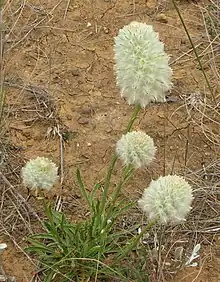| Ptilotus macrocephalus | |
|---|---|
 | |
| Scientific classification | |
| Kingdom: | Plantae |
| Clade: | Tracheophytes |
| Clade: | Angiosperms |
| Clade: | Eudicots |
| Order: | Caryophyllales |
| Family: | Amaranthaceae |
| Genus: | Ptilotus |
| Species: | P. macrocephalus |
| Binomial name | |
| Ptilotus macrocephalus (R.Br.) Poir | |
Ptilotus macrocephalus (commonly as featherheads, green mulla mulla or green pussytails) is a native Australian perennial herb growing up to 50 centimetres (20 in) high.[1] The species was originally described as Trichinium macrocephalum by Robert Brown in 1810 based on specimens from Victoria, Australia.[2] In 1816, it was first transferred to the genus Ptilotus by Jean Louis Marie Poiret.[3] While once considered distributed throughout most of the Australian mainland, current research limits the distribution of P. macrocephalus to south-eastern Australia, mostly in south-eastern South Australia, Victoria and New South Wales.[1] A study by Hammer et al. (2019) determined that specimens previously identified as P. macrocephalus are morphologically and ecologically distinct species, the now named Ptilotus xerophilus T.Hammer & R.W.Davis (arid central and western Australia) and Ptilotus psilorhachis T.Hammer & R.W.Davis (eastern Queensland).[1]
P. macrocephalus has cream-green coloured ovoid flower heads.[1] As with other green-flowered Ptilotus species (e.g. Ptilotus nobilis), they are thought to be predominantly pollinated by nocturnal moths.[1]
References
- 1 2 3 4 5 Hammer, Timothy; Davis, Robert; Thiele, Kevin (8 May 2019). "Of a different feather: two new species of featherheads from the Ptilotus macrocephalus (Amaranthaceae) complex". Australian Systematic Botany. 32 (1): 61–70. doi:10.1071/SB18065.
- ↑ Brown, Robert (1810). Prodromus florae Novae Hollandiae et Insulae Van-Diemen, exhibens characteres plantarum. Londini: typis R. Taylor et socii. doi:10.5962/bhl.title.3678.
- ↑ Lamarck, Jean-Baptiste; Poiret, Jean-Louis-Marie (1810). Encyclopédie méthodique. Botanique. Supplement. Paris: Agasse. doi:10.5962/bhl.title.826.